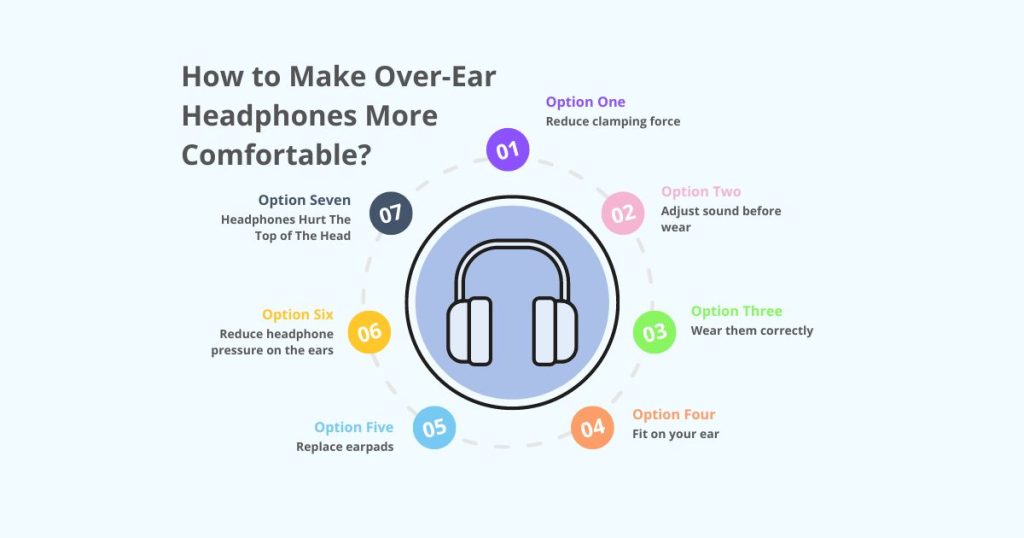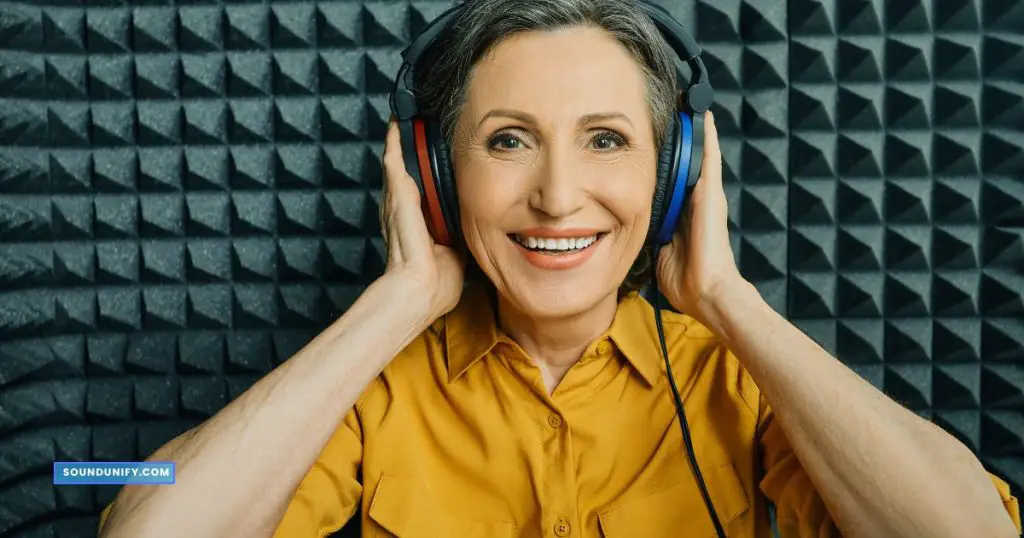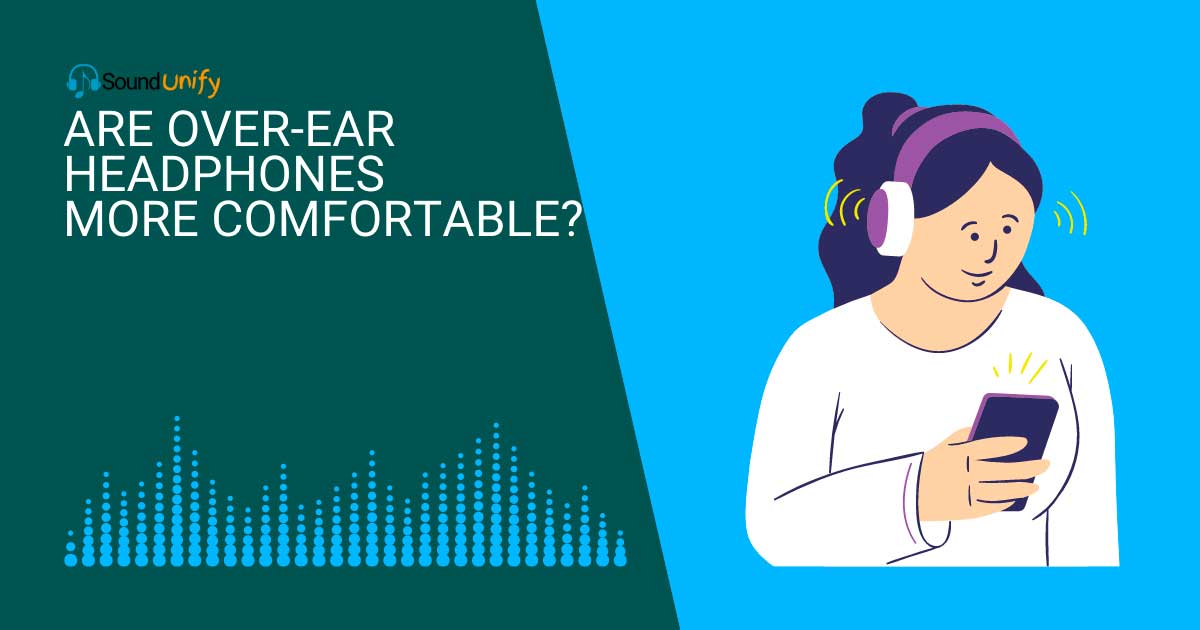Yes, over-ear headphones are generally more comfortable for extended use. They distribute pressure evenly around your ears rather than pressing on them.
You’re here because you’ve felt the ear fatigue, discomfort, and “I can’t wear these for one more second” feeling. I get it; I’ve been there too. You’re wondering if over-ear headphones could solve your aural woes. Well, you’re in the right place.
Let’s talk about why those tiny earbuds or on-ear options might be causing you grief. They press directly on your ears, leading to soreness over time.
Plus, they often don’t offer the best sound quality. Conversely, Over-ear headphones envelop your ears in cushioned comfort while delivering superior sound.
But it’s not all sunshine and rainbows. Over-ear headphones can be bulky; not everyone finds them the epitome of style. So, are over-ear headphones more comfortable?
Stick around, and let’s dive into the nitty-gritty of over-ear headphone comfort. Trust me, your ears will thank you.
10 Reasons Why Are Over-Ear Headphones Comfortable

It varies from man to man which types of headphones are more comfortable. Some can prefer on-ear headphones; others’ choices may be over-ear headphones. On the other hand, some can go straight for earbuds.
You can say that over-ear headphones are more comfortable for a few reasons.
- Full Ear Coverage: Over-ear headphones cover the entire ear, distributing pressure evenly and preventing direct pressure on the earlobes or ear cartilage.
- Padded Ear Cups: Most over-ear headphones come with thick, cushioned ear cups that provide a soft barrier between the headphones and the ears, enhancing comfort.
- Adjustable Headbands: These headphones often feature adjustable headbands, allowing users to find the perfect fit for their head size and shape.
- Weight Distribution: The design of over-ear headphones often distributes their weight evenly across the head, preventing pressure points.
- Noise Isolation: The full ear coverage helps in passive noise isolation, which means users don’t need to increase the volume to drown out external noises, leading to a more comfortable listening experience.
- Breathability: Many over-ear headphones are designed with materials that allow the ears to breathe, reducing the chances of sweating and discomfort during prolonged use.
- Durability and Longevity: Over-ear headphones tend to be robust and long-lasting. Knowing they won’t easily break adds to the comfort of using them without worry.
- Less Ear Fatigue: The design of over-ear headphones can lead to less ear fatigue compared to in-ear or on-ear headphones, especially during extended listening sessions.
- Customizable Comfort: Some over-ear headphones come with replaceable ear pads, allowing users to choose materials and thickness levels that suit their comfort preferences.
- Balanced Sound: Over-ear headphones often provide a more spacious and balanced soundstage. This can make listening more enjoyable and less fatiguing, as sounds are not directly funneled into the ear canal.
While many people find over-ear headphones comfortable, comfort is subjective and can vary from person to person. It’s always a good idea to try on a pair of headphones before purchasing to ensure they fit well and feel comfortable.
How to Make Over-Ear Headphones More Comfortable?

As you can see, many advantages include using over-ear headphones. But is that all? No, it may be uncomfortable also. We can make uncomfortable headphones by following some easy steps.
1. Reduce clamping force
The headphone exerts some pressure on your head when you put them on. Sometimes it is manageable, but sometimes this stress becomes too much. You may feel a headache after using it for a long time.
The ideal clamping force is between 0.6 lbs and 1.3 lbs. So, adjusting the clamping force to your comfort level is essential. Here are some methods to do so.
- Use a softer ear pad: This will help reduce the pressure exerted on the ears and make the headphones more comfortable for long periods.
- Loosen the headband: To reduce the clamping force, you can try to loosen the headband. Many headphones have this option. So, if you feel pressure on your skull, it is small according to your size.
- Adjust the headband: Make sure that the headband is not too tight or loose because tight headphones can also contribute to increased clamping force. On the other hand, a loose one will fall from your head, making the sound quality poor.
- Take breaks: If your headphones are causing discomfort after a period of use, take a break and give your ears a chance to rest.
- Stretching Headphones: One way to reduce the clamping force on headphones is to stretch them. You can hold the headphones in both hands and gently pull them apart. Be careful not to break the headband.
2. Adjust sound before wear
Before putting on over-ear headphones, take a moment to adjust the sound. Just follow these steps.
- Start with the volume low and increase it gradually until you reach a comfortable level.
- If you have an equalizer, adjust the bass and treble.
- If you have noise-cancelling headphones, turn on the noise-cancelling feature.
- Maintain the 60-60 rules of using headphones to prevent hearing damage. That is, raise the volume not more than 60% and try not to listen to music for more than 60 minutes daily.
- Once you have the sound the way you want, pair the headphones and enjoy your music.
3. Wear them correctly
Wearing over-ear headphones correctly can help you hear the audio more clearly. It can also help block out external noise so you can focus on the audio.
When wearing over-ear headphones, ensure the ear cup is positioned over your ear, and the headband is snug but not too tight.
4. Fit on your ear
Before wearing it, ensure that it fits snugly on your ears. If your headphones are too loose, they may fall off during use and become damaged.
Still, if you have difficulty fitting your over-ear headphones on your ears, ask a friend or family member for help. It will also help if you read the manufacturer’s instructions on properly fitting your over-ear headphones on your ears.
You can use a wire to adjust the headphone to your head. First, band the wire wider than the width of your head. Then secure it to your headphones.
If it hurts, then band the wire wider. Make the wire tighter according to your comfort level if it is loose.
5. Replace earpads
Generally, earpads are made with synthetic leather, original leather, or velour. You must take care of them properly; otherwise, they will lose shape.
If your earpads are too big or small, replace them with a different size. Earpads that are too big can cause discomfort, while earpads that are too small can cause sound leakage.
There are many different sizes of earpads available. So, you can find a size that fits your ears perfectly.
6. Reduce headphone pressure on the ears
Most headphones are designed in the market based on the average head and ear sizes. It doesn’t need to fit perfectly on your ear. So, you can follow these instructions to find the desired one.
It will be best if you can wear the headphones before buying them. For that, go to the shop instead of ordering it online, wear it for some moments, and feel the pressure it gives, and when you find the right one, buy it.
Try the adjustable features that come with the headphones. Manufacturers include some flexible parts on different models of headphones. So, check out how the earcups rotate.
Try to adjust the headband according to your head size. Finally, look if all the moving parts are smooth and work correctly.
Find out about the proper padding of the headphones. If the clamping force is low, you will need thicker headband padding and vice versa. So, choose them wisely to avoid a headache.
7. Headphones Hurt The Top of The Head
If you don’t have an adjustable headphone, if its clamping force is high, or if the headband is smaller according to your head, it can cause pain. Here are some easy steps to stop the pain.
Add a good quality and soft cushion underneath your headband. Try to use lycra, neoprene, or microfiber, as those are high in quality. Don’t forget to widen the headband before installing the cushion.
Remove the old padding and add a new soft pad to your headphone. You can get help from YouTube or a professional to fix this issue.
What Is Ear Size Comfortable for Wearing Over-Ear Headphones?

We all know that every human is different from others. That goes with ear size also. A shallow or thin earcup padding doesn’t contain enough support to comfort your ear.
As a result, pain is caused in your ear cartilage. To get rid of it, replace it with a thick earpad that will cushion your ear.
Also, don’t forget to choose the proper breathable padding made with velour, leather, or microfiber. Choose the right size and prolong your music experience with joy.
Here’s a table that provides a general guideline on ear sizes and their comfort levels for wearing over-ear headphones:
| Ear Size | Comfort Level for Over-Ear Headphones | Notes |
|---|---|---|
| Small | Moderate | It might feel snug, but many headphones have spacious ear cups to accommodate larger ears. |
| Medium | High | Typically the most comfortable as most over-ear headphones are designed for average ears. |
| Large | Moderate to High | Might feel snug, but many headphones have spacious ear cups to accommodate larger ears. |
| Extra Large | Moderate | Might require headphones with extra-large ear cups for optimal comfort. |
Which Are More Comfortable On-Ear or Over-Ear Headphones?
The comfort level between on-ear and over-ear headphones can vary based on individual preferences, the design of the headphones, and the intended use. Here are some general differences and considerations:
On-Ear Headphones:
- Size and Weight: On-ear headphones are generally smaller and lighter than over-ear headphones. This can make them more portable and less cumbersome to wear.
- Pressure on Ears: Since they rest directly on the ears, some people find on-ear headphones to exert more pressure, which can become uncomfortable over extended periods.
- Heat: On-ear headphones might cause the ears to warm after prolonged use.
- Ambient Noise: They typically provide less noise isolation than over-ear headphones, meaning you might hear more of your surroundings.
Over-Ear Headphones:
- Size and Weight: Over-ear headphones are larger and might be heavier, which can be a factor for those prioritizing portability.
- Pressure Distribution: They encase the entire ear, distributing pressure around the ear rather than directly on it. Many people find this more comfortable for extended listening sessions.
- Heat: While they can also cause warmth around the ears, the larger ear cups might offer better ventilation.
- Noise Isolation: Over-ear headphones generally provide better passive noise isolation, meaning they can block out more ambient noise.
Other Factors to Consider:
- Material: The material of the ear pads can significantly impact comfort. Memory foam, leather, and velour are some common materials used.
- Clamping Force: The force the headphones press against the head can affect comfort. Some headphones have adjustable headbands to mitigate this.
- Intended Use: On-ear might be more convenient if you use headphones for short durations or while moving. Over-ear might be preferable for extended listening sessions at home or in a studio.
The best way to determine which type is more comfortable is to try them out personally. Comfort is subjective, and what works for one person might not work for another.
FAQs
Q. Why do my ears hurt after wearing headphones for a long time
Wearing tight headphones according to your head size can pressure your ear cartilage. This is because the cartilage in your ears is not meant to be constantly compressed against something like headphones. Over time, this can lead to the cartilage becoming misshapen and causing pain. If you experience ear pain while using headphones, taking a break and giving your ears a chance to rest is best.
Q. Are over-the-ear headphones comfortable for traveling?
Over-the-ear headphones are great for traveling because they are very comfortable. Having a bigger earcup puts little or almost no pressure on your ear. They also provide good noise cancellation, which is essential when sleeping on a plane or in a noisy hotel room.
Q. Can earcups or earpads feel uncomfortable?
Both earpads and earcups can feel uncomfortable if they are not the right size or shape for your ears. If they are made of non-breathable material will cause your ears to sweat. Moreover, if the earpads or earcups are too tight, they can cause pain or discomfort.
Are over-ear headphones comfortable?
Over-ear headphones are more comfortable because they don’t pressure the ear. They are also more stable and won’t fall off as easily. It has wide earcups in comparison to other types of headphones. Soft earpads make it worth your budget and time.
Final Thought
Ultimately, you will decide which headphones are more comfortable to use. Everyone’s tastes are different, and so are everyone’s comfort levels.
But, some measurements and techniques exist to find comfortable and cozy over-ear headphones for you. Try to find your best-to-go headphones and enjoy your moment.
You can get the right headphones using this information. Also, you can save your pocket by avoiding the wrong one.
James Dimento is a Chief-in-Editor of SoundUnify. He is a headphone enthusiast and creative writer passionate about audio technology. He has three years of experience writing about headphones and sound quality and is responsible for creating reviews and taking care of all administration.
